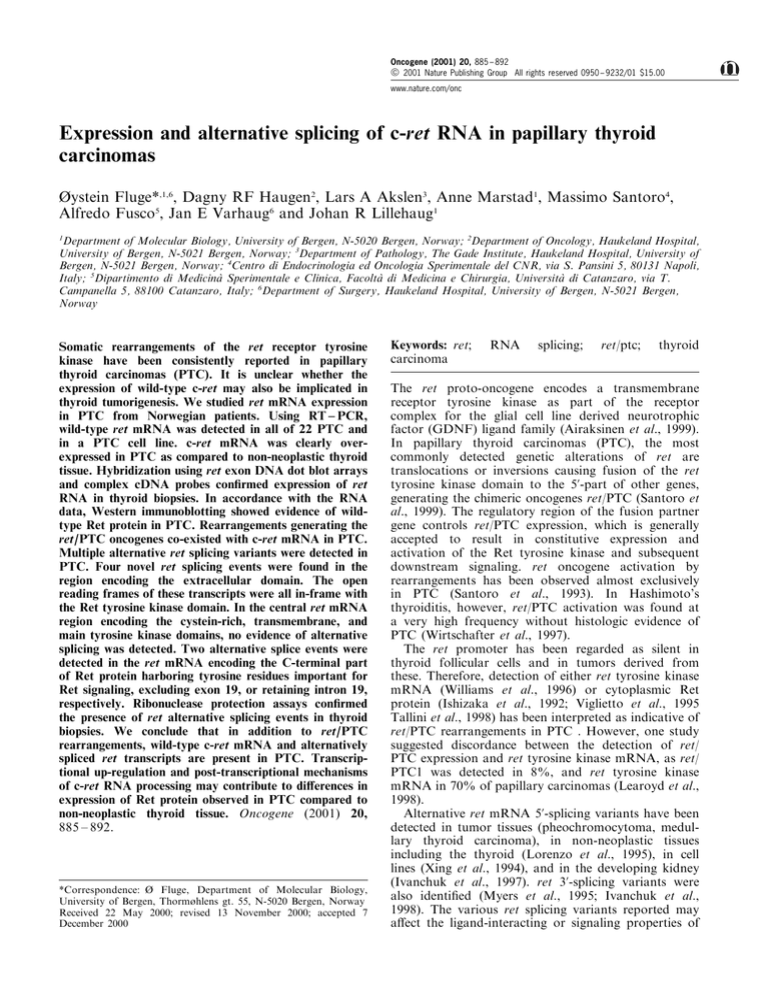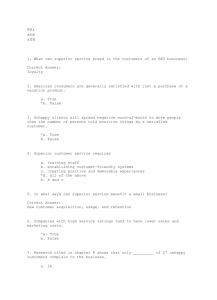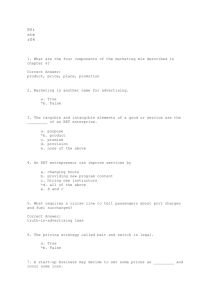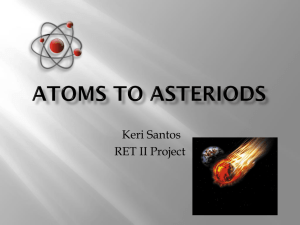
Oncogene (2001) 20, 885 ± 892
ã 2001 Nature Publishing Group All rights reserved 0950 ± 9232/01 $15.00
www.nature.com/onc
Expression and alternative splicing of c-ret RNA in papillary thyroid
carcinomas
éystein Fluge*,1,6, Dagny RF Haugen2, Lars A Akslen3, Anne Marstad1, Massimo Santoro4,
Alfredo Fusco5, Jan E Varhaug6 and Johan R Lillehaug1
1
Department of Molecular Biology, University of Bergen, N-5020 Bergen, Norway; 2Department of Oncology, Haukeland Hospital,
University of Bergen, N-5021 Bergen, Norway; 3Department of Pathology, The Gade Institute, Haukeland Hospital, University of
Bergen, N-5021 Bergen, Norway; 4Centro di Endocrinologia ed Oncologia Sperimentale del CNR, via S. Pansini 5, 80131 Napoli,
Italy; 5Dipartimento di MedicinaÁ Sperimentale e Clinica, FacoltaÁ di Medicina e Chirurgia, UniversitaÁ di Catanzaro, via T.
Campanella 5, 88100 Catanzaro, Italy; 6Department of Surgery, Haukeland Hospital, University of Bergen, N-5021 Bergen,
Norway
Somatic rearrangements of the ret receptor tyrosine
kinase have been consistently reported in papillary
thyroid carcinomas (PTC). It is unclear whether the
expression of wild-type c-ret may also be implicated in
thyroid tumorigenesis. We studied ret mRNA expression
in PTC from Norwegian patients. Using RT ± PCR,
wild-type ret mRNA was detected in all of 22 PTC and
in a PTC cell line. c-ret mRNA was clearly overexpressed in PTC as compared to non-neoplastic thyroid
tissue. Hybridization using ret exon DNA dot blot arrays
and complex cDNA probes con®rmed expression of ret
RNA in thyroid biopsies. In accordance with the RNA
data, Western immunoblotting showed evidence of wildtype Ret protein in PTC. Rearrangements generating the
ret/PTC oncogenes co-existed with c-ret mRNA in PTC.
Multiple alternative ret splicing variants were detected in
PTC. Four novel ret splicing events were found in the
region encoding the extracellular domain. The open
reading frames of these transcripts were all in-frame with
the Ret tyrosine kinase domain. In the central ret mRNA
region encoding the cystein-rich, transmembrane, and
main tyrosine kinase domains, no evidence of alternative
splicing was detected. Two alternative splice events were
detected in the ret mRNA encoding the C-terminal part
of Ret protein harboring tyrosine residues important for
Ret signaling, excluding exon 19, or retaining intron 19,
respectively. Ribonuclease protection assays con®rmed
the presence of ret alternative splicing events in thyroid
biopsies. We conclude that in addition to ret/PTC
rearrangements, wild-type c-ret mRNA and alternatively
spliced ret transcripts are present in PTC. Transcriptional up-regulation and post-transcriptional mechanisms
of c-ret RNA processing may contribute to dierences in
expression of Ret protein observed in PTC compared to
non-neoplastic thyroid tissue. Oncogene (2001) 20,
885 ± 892.
*Correspondence: é Fluge, Department of Molecular Biology,
University of Bergen, Thormùhlens gt. 55, N-5020 Bergen, Norway
Received 22 May 2000; revised 13 November 2000; accepted 7
December 2000
Keywords: ret;
carcinoma
RNA
splicing;
ret/ptc;
thyroid
The ret proto-oncogene encodes a transmembrane
receptor tyrosine kinase as part of the receptor
complex for the glial cell line derived neurotrophic
factor (GDNF) ligand family (Airaksinen et al., 1999).
In papillary thyroid carcinomas (PTC), the most
commonly detected genetic alterations of ret are
translocations or inversions causing fusion of the ret
tyrosine kinase domain to the 5'-part of other genes,
generating the chimeric oncogenes ret/PTC (Santoro et
al., 1999). The regulatory region of the fusion partner
gene controls ret/PTC expression, which is generally
accepted to result in constitutive expression and
activation of the Ret tyrosine kinase and subsequent
downstream signaling. ret oncogene activation by
rearrangements has been observed almost exclusively
in PTC (Santoro et al., 1993). In Hashimoto's
thyroiditis, however, ret/PTC activation was found at
a very high frequency without histologic evidence of
PTC (Wirtschafter et al., 1997).
The ret promoter has been regarded as silent in
thyroid follicular cells and in tumors derived from
these. Therefore, detection of either ret tyrosine kinase
mRNA (Williams et al., 1996) or cytoplasmic Ret
protein (Ishizaka et al., 1992; Viglietto et al., 1995
Tallini et al., 1998) has been interpreted as indicative of
ret/PTC rearrangements in PTC . However, one study
suggested discordance between the detection of ret/
PTC expression and ret tyrosine kinase mRNA, as ret/
PTC1 was detected in 8%, and ret tyrosine kinase
mRNA in 70% of papillary carcinomas (Learoyd et al.,
1998).
Alternative ret mRNA 5'-splicing variants have been
detected in tumor tissues (pheochromocytoma, medullary thyroid carcinoma), in non-neoplastic tissues
including the thyroid (Lorenzo et al., 1995), in cell
lines (Xing et al., 1994), and in the developing kidney
(Ivanchuk et al., 1997). ret 3'-splicing variants were
also identi®ed (Myers et al., 1995; Ivanchuk et al.,
1998). The various ret splicing variants reported may
aect the ligand-interacting or signaling properties of
Alternative splicing of c-ret in papillary carcinomas
é Fluge et al
886
the receptor (Lorenzo et al., 1997; van Weering and
Bos, 1998).
In the course of studying gene expression in thyroid
carcinomas, we detected wild-type ret transcripts in
several thyroid biopsies. This ®nding was surprising,
given the current knowledge of c-ret expression in the
thyroid gland. We therefore investigated whether c-ret
mRNA and protein actually were expressed in the
thyroid, and especially in PTC known to harbor ret/
PTC rearrangements. Using RT ± PCR, ribonuclease
protection assays, and DNA dot blot hybridization
with complex cDNA probes, we found that incompletely and several novel alternatively spliced c-ret
transcripts are frequently present in various types of
thyroid tissue, including PTC biopsies and a PTC cell
line. We report that c-ret mRNA and Ret protein are
expressed in papillary carcinomas in addition to the
chimeric ret/PTC transcripts.
Wild-type c-ret mRNA and protein in PTC
To test for the presence of c-ret speci®c RNA, we
initially performed RT ± PCR (35 cycles) using primer
pairs for the intracellular tyrosine kinase domain
(Retex15-F/Retex19-R), and for the region encoding
the transmembrane domain located to exon 11
(Retex9-F/Retex12-R) (Table 1). These experiments
showed the presence of both ret tyrosine kinase (data
not shown) and ret transmembrane/extracellular domain mRNA in each of the 36 biopsies investigated,
including 22 PTC, four medullary carcinomas, two
follicular adenomas, and also in samples of nonneoplastic thyroid tissue (representative samples in
Figure 1a). To estimate the dierences in amount of
wild-type ret mRNA present in thyroid biopsies of
various histologic type, a duplex RT ± PCR was
performed using b-actin and c-ret speci®c primer sets
(Table 1). b-actin was co-ampli®ed as an internal
control of RNA quality and amount, and the ®rst
cycles detecting the b-actin and ret bands, respectively,
were compared. The results of representative experiments are demonstrated in Figure 1b. In non-
neoplastic thyroid biopsies, c-ret mRNA was not
reliably detected until after 34 PCR cycles, thus
indicating very low levels of mature c-ret mRNA. In
contrast, c-ret was signi®cantly over-expressed in PTC
samples. The level of wild-type ret mRNA in dierent
PTC biopsies, normalized relative to the b-actin
mRNA levels, was estimated to be in the range 1 ±
12%, as compared to the c-ret mRNA level in the
medullary carcinoma biopsy (Figure 1b).
Identi®cation of signi®cant amounts of wild-type ret
mRNA indicated that the wild-type Ret protein could
be expressed in PTC. We therefore performed protein
immunoblot experiments using the three polyclonal
antibodies sc-167g, sc-167, and anti-RetTK. All three
antibodies readily detected two bands of molecular
weight approximately 155 and 175 kDa in protein
extracts of medullary carcinoma biopsies (Figure 1c),
corresponding to the dierent glycosylated forms of
wild-type Ret protein. These two protein bands could
also be weakly, but distinctly, detected in some of the
papillary carcinoma biopsies when loading the gel with
a high amount of protein (200 ± 300 mg). In protein
extracts of non-neoplastic thyroid biopsies Ret-speci®c
bands were not observed (not shown). Protein bands
corresponding to the chimeric ret/PTCs, or to the
alternatively spliced c-ret transcripts, could not be
reliably detected in the Western immunoblot experiments. Altered protein stability and rapid turnover of
these putative Ret protein isoforms may reduce their
amounts below the detection limit. However, such Ret
protein variants might nevertheless have biological
functions of importance.
Thus, we demonstrate the expression of signi®cant
amounts of wild-type c-ret mRNA and Ret protein in
PTC. RT ± PCR results could be in¯uenced by c-ret
mRNA contamination from stromal cells, lymphocytes
(Visser et al., 1996), or parafollicular C-cells in normal
thyroid tissue. These sources of ret transcripts are,
however, unlikely as an explanation for the observed cret mRNA in papillary carcinomas since in situ
hybridization did not show evidence of ret mRNA
expression in lymphocytes or stromal cells (Lam et al.,
Table 1 Primer names, sequences, positions in Genbank accessions, and annealing temperatures used for RT ± PCR
Name
Sequence (5' ± 3')
Genbank accession;
position in mRNA
Retex1-F
Retex3-F
Retex8-R
Retex9-F
Retex9-R
Retex12-R
Retex15-F
Retex16-F
Retex17-R
Retex19-R
Retint20-R
Retex21-R
Actin-F
Actin-R
gcacccgccatccagacc
ctgctcaccgtctacctc
gccgccacactcctcacact
acttctccacctgctctcc
ggtctccacaacatcgcagt
gttgccttgaccacttttc
tcccgagatgtttatgaa
ggagccagggtcggattccagtta
ccgctcaggaggaatcccaggata
cgcaaggtccaagtagtc
ccccctttcttcatactg
gctgtttagacctggagttc
ggcaccacaccttctaca
aggaaggctggaagagtg
X15262; 81 ± 98
X15262; 501 ± 518
X12949; 1530 ± 1511
X12949; 1592 ± 1610
X12949; 1656 ± 1637
X12949; 2156 ± 2138
X12949; 2617 ± 2634
X12949; 2654 ± 2677
X12949; 2808 ± 2785
X12949; 2988 ± 2971
X12949; 4102 ± 4085
S80097; 3333 ± 3314
NM_001101; 330 ± 347
NM_001101; 869 ± 852
a
Annealing
temperaturesa
References
61 ± 57
61 ± 57
60
58 ± 56
63 ± 59
61 ± 56
55
57
57
56
61 ± 57
61 ± 57
56
56
this study
this study
this study
this study
this study
this study
this study
Nikiforov
Nikiforov
this study
this study
this study
this study
this study
The notation of two temperatures (e.g. 61 ± 57) indicates the interval of annealing temperatures used when the actual primer was used in PCR
Oncogene
Alternative splicing of c-ret in papillary carcinomas
é Fluge et al
887
Figure 1 c-ret mRNA and Ret protein expression in papillary carcinomas. The biopsies were processed as previously reported
(Fluge et al., 2000). Total RNA was extracted, DNase I treated (MessageClean Kit, Genhunter, Nashville, TN, USA), and subjected
to ®rst-strand cDNA synthesis primed by oligo-dT16 and random nucleotide hexamer, using Superscript II reverse transcriptase, and
RNase H treated (Gibco ± BRL, Gaithersberg, MD, USA). One ml of the ®rst-strand reaction mixture was used as template in a 50 ml
PCR. The primers and annealing temperatures used for PCR are given in Table 1. Either Amplitaq (Perkin Elmer, Norwalk, CT,
USA) or Advantage2 (Clontech, Palo Alto, CA, USA) was used in all PCR experiments (GeneAmp 2400, Perkin Elmer).
Representative samples of each RT ± PCR product were sequenced in both directions with the appropriate primers (Table 1), either
directly after puri®cation (Qiaquick PCR Puri®cation Kit, Qiagen, Santa Clara, CA, USA), or after TA-cloning (pCR2.1-TOPO)
(Invitrogen, San Diego, CA, USA) (Fluge et al., 2000). (a) Representative samples from RT ± PCR using primers designed to detect a
565 bp wild-type c-ret fragment (primers Retex9-F/Retex 12-R, 35 PCR cycles). (b) For the semiquantitative assessment of c-ret
mRNA, a duplex RT ± PCR was performed using the primers Retex9-F/Retex19-R amplifying a 1397 bp wild-type c-ret cDNA
fragment, and a primer pair amplifying a 540 bp b-actin fragment included as an internal control of mRNA amount and quality. The
PCR was performed in 100 ml initial reaction volume including 1 ml cDNA, Advantage2 (Clontech) was used as the polymerase,
annealing temperature was 568C, and 10 ml aliquots were removed every third PCR cycle, from cycle 13 until cycle 34, and analysed
on ethidium bromide stained agarose gels. Representative samples including a medullary carcinoma, two PTC, and one nonneoplastic thyroid specimen, are shown. The arrows indicate the 1397 bp ret and the 540 bp b-actin fragments. No c-ret speci®c RT ±
PCR fragments were detected using cDNA made from ®broblast total RNA (not shown). (c) Parts of the histologically representative
snap-frozen biopsies were crushed and proteins solubilized in extraction buer as reported (Fluge et al., 2000). Approximately 250 mg
protein from each biopsy was acetone precipitated, washed twice in acetone, dissolved in sample buer with b-mercaptoethanol,
boiled for 10 min and separated on 7.5% SDS (sodium dodecyl sulphate) polyacrylamide gels. Electroblotting and blocking were
performed as described. The membranes were then incubated for 2 h at room temperature with primary antibody diluted 1 : 400 in
1% dry milk. Ret protein was assessed by the goat polyclonal antibody sc-167 g (Santa Cruz Biotechnology, Santa Cruz, CA, USA)
(c, left panel), the rabbit polyclonal antibody sc-167 (Santa Cruz) (c, mid panel), and by the rabbit polyclonal anti-RetTK antibody
(Santoro et al., 1994) (c, right panel). After several washes in TBS-Tween, the membranes were incubated 1 h at room temperature
with the secondary antibody, then washed with TBS-Tween and subjected to enhanced chemiluminescence (ECL) (Amersham). As
secondary antibodies, sc-2020 (HRP-conjugated anti goat IgG) (Santa Cruz) diluted 1 : 6000 in 5% dry milk (c, left panel), or HRPconjugated donkey anti rabbit IgG) (Amersham, Chicago, IL, USA) diluted 1 : 500 in 1% dry milk (c, mid and right panels), were
used. Negative controls omitting the primary antibody were run in parallel. The star (*) marks Ret protein expression also in
papillary carcinomas. Abbreviations are; ptc: papillary thyroid carcinoma; mc: medullary carcinoma; fa: follicular adenoma; nt: nonneoplastic thyroid tissue; +RT: including reverse transcriptase in cDNA synthesis; 7RT: omitting reverse transcriptase from cDNA
synthesis; M: molecular weight marker. The number given for each biopsy refers to the patient code number in our tissue bank
Oncogene
Alternative splicing of c-ret in papillary carcinomas
é Fluge et al
888
1998). The c-ret expression demonstrated in the human
PTC cell line NPA further supports our interpretation
that c-ret mRNA is expressed in PTC. Also, the very
low levels of c-ret mRNA in the non-neoplastic
biopsies (Figure 1b) argues against another source of
expression than the tumor cells.
ret mRNA splice variants in PTC
We further wanted to analyse for the presence of ret
splicing variants using RT ± PCR with primer combinations covering the dierent regions of ret mRNA. In
total, six ret splicing events aecting the coding region
were identi®ed, ®ve of these have not been described
previously (Table 2). The relevant primer sequences are
given in Table 1. A schematic indication of the splicing
events and positions of primers, related to c-ret
mRNA, is presented in Figure 2f. In all RT ± PCR
experiments, controls omitting the reverse transcriptase
from the cDNA synthesis reactions were negative.
The region of c-ret mRNA encoding the extracellular
and transmembrane domains was investigated using a
forward primer in exon 1 (Retex1-F) and a reverse
primer in exon 12 (Retex12-R). Five RT ± PCR
fragments were generated, of which four were found
to be ret-speci®c after cloning and DNA sequencing,
three of these are shown in Figure 2a. The 2294 bp
PCR-product corresponded to the wild-type ret mRNA
(Takahashi et al., 1988, 1989). A novel alternatively
spliced c-ret transcript was detected, in which the
segment corresponding to exons 4 ± 7 (897 nts) was
lacking. The ret transcript harboring this splice event
was designated ret3 ± 8 (Figure 2a; Table 2). The ret3 ±
8 splicing was a frequent event in thyroid biopsies,
being detected (35 PCR cycles) in all of seven PTC,
four medullary carcinomas, one follicular carcinoma,
in some samples of non-neoplastic thyroid tissue, and
also in one pheochromocytoma analysed (Figure 2c).
The PTC cell line (NPA) also harbored the ret3 ± 8
splice variant (Figure 2b). The ret3 ± 8 splicing was
independently veri®ed by sequencing cDNA from
biopsies from each of ®ve patients. Other novel
Table 2
Namea
ret1 ± 8c
ret2 ± D3d
ret2 ± 8
ret3 ± 8
ret18 ± 20e
ret ± i19f
ret ± i20g
a
Exon splice
donor
ctaggcaaag
agtgtccgca
agtgtccgca
ctcctggagg
ctggtggact
transcripts, ret2 ± 8 (lacking exons 3 through 7), and
ret1 ± 8 (lacking exons 2 through 7), were also identi®ed
(Figure 2a). An additional transcript (ret2 ± D3) in
which exon 2 was joined to an alternative splice
acceptor within exon 3 had a spliced-out segment
encompassing 129 nucleotides, as compared to c-ret
mRNA (Table 2). The open reading frames of the
ret1 ± 8, ret2 ± D3, ret2 ± 8, and ret3 ± 8 splicing variants
were all predicted to be in-frame with the tyrosine
kinase domain. Previously, three alternative splice
variants located to the extracellular domain of c-ret
have been identi®ed in a medullary carcinoma cell line
(Lorenzo et al., 1995). These variants, lacking either
exon 3, exons 3 and 4, or exons 3, 4, and 5, were not
detected in our thyroid biopsies. The splice variants in
the extracellular domain reported previously and in the
present study, may aect the interaction between Ret
and the GDNFRa coreceptor/GDNF ligand complex
(Treanor et al., 1996). This diversity may provide
opportunities for dierential ligand interaction and
speci®c downstream signaling. No evidence of ret
mRNA splicing was found in the region covering
exons 8 ± 18, i.e. across the regions encoding the
cystein-rich, transmembrane, and major tyrosine kinase
domains. Multiple primer combinations (Table 1;
Figure 2f) covering this region were used, each
experiment showing only one PCR product of expected
wild-type size and sequence (not shown).
In the 3'-part of ret mRNA, two splicing events
aecting the coding region were detected (Table 2,
Figure 2f). A ret transcript retaining intron 19 was
identi®ed (Table 2) when the reverse primer Retint20R, located in the alternative intron 20 (Myers et al.,
1995), was used in combination with a forward primer
from exon 3 (Retex3-F). This splice variant has
previously been described (Tahira et al., 1990). The
presence of intron 19 in ret mRNA aects the Cterminal region generating the Ret9 protein, as
opposed to the Ret51 protein when exon 19 is spliced
to exon 20 (Myers et al., 1995). The Ret9 protein lacks
Y1090 and Y1096, both targets for Grb2 interaction,
but maintains the Shc interacting Y1062, providing
Alternative splice variants of c-ret detected in papillary thyroid carcinomas
Intron
5' sequence
gtaagggagch
gggagccgcch
gtgagtgccgh
gtaataatgc
no splicing
no splicing
Intron
3' sequence
Exon splice
acceptor
Splicing
class
Spliced
region
(nts)b
Normal
exon-intron
border
Coding
region
affected
ccacctgcagh
tcctttccag
ccacctgcagh
ccacctgcagh
tcatttttagi
atgtggccga
cctgcagctc
atgtggccga
atgtggccga
gcatgtcaga
gt/ag
gt/ag
gt/ag
gt/ag
gt/ag
1449
129
1185
897
60
yes ± yes
yes ± no
yes ± yes
yes ± yes
yese ± yes
yes
yes
yes
yes
yes
yes
no
The novel ret1 ± 8, ret2 ± D3, ret2 ± 8, ret3 ± 8 and ret18 ± 20 splicing variants have not been described previously. bThe spliced region denotes the
number of nucleotides (nts) lacking as compared to the wild-type c-ret mRNA. cThe ret1 ± 8 denotes a splice event in which the 3'-end of exon 1
is joined to the 5'-end of exon 8 (lacking exons 2 through 7). dThe ret2 ± D3 denotes a splice event in which exon 2 is joined to an alternative
splice acceptor within exon 3 (lacking 129 nucleotides of exon 3). eExons 18, 19 and 20 sequences according to Kwok et al. (1993). fIn the ret-i19
transcript, intron 19 was present in mRNA. gIn the ret-i20 transcript, the complete intron 20 was present in mRNA. hIntron sequences according
to Ceccherini et al. (1993). iIntron 19 and 20 sequences according to Myers et al. (1995)
Oncogene
Alternative splicing of c-ret in papillary carcinomas
é Fluge et al
889
Figure 2 Detection of alternatively spliced ret transcripts. cDNA was made from DNase I-treated total RNA from dierent
thyroid tissue specimens, and subjected to PCR. The primer sequences and annealing temperatures used are indicated in Table 1.
The speci®city of each PCR-product was veri®ed by cloning and sequencing, as described. (a) RT ± PCR fragments generated from a
PTC biopsy obtained using the primers Retex1-F/Retex12-R (Table 1). The ret splicing variants corresponding to each of these
fragments are indicated (ret-wt, ret3 ± 8, ret2 ± 8, and ret1 ± 8). (b) Detection of alternatively spliced ret3 ± 8 transcripts in the PTC
cell line NPA (de Nigris et al., 1998). The NPA cell line was maintained in Dulbecco's modi®ed eagle medium (DMEM) with 10%
fetal calf serum and 1% glutamine. (c) The presence of the ret3 ± 8 splice variant in several thyroid biopsy specimens is demonstrated
by RT ± PCR (35 cycles) using the primers Retex3-F/Retex12-R amplifying a 977 bp fragment. (d) RT ± PCR products generated
from a PTC biopsy using the primers Retex16-F/Retex21-R, showing the presence of c-ret mRNA including (ret-i20), or excluding
(ret-wt), intron 20. (e) Demonstration of ret wild-type (ret-wt), and the ret18 ± 20 splicing event in two papillary carcinomas, using
the primers Retex9-F/Retex21-R. (f) Alternatively spliced ret transcripts with the spliced regions marked relative to c-ret mRNA
and ret exons. Ret exon 19 was designated 19a and 19b, and refers to the discrepancy in exon borders published by Ceccherini (19a)
(Ceccherini et al., 1993) and Kwok (19b) (Kwok et al., 1993). Arrows indicate the primers used in RT ± PCR. Abbreviations as in
Figure 1, and; fc: follicular carcinoma; pheo: pheochromocytoma
Oncogene
Alternative splicing of c-ret in papillary carcinomas
é Fluge et al
890
Figure 3 ret splicing variants detected by ribonuclease protection assay (a and b) and ret RNA expression detected by hybridization
using complex cDNA probes (c). Ribonuclease protection assays were performed using the RPA III kit (Ambion, Austin, TX, USA).
The category of tissue used for extraction of total RNA is indicated below panel a and b. The protected fragments are indicated to the
right of each panels a and b. The star marks the presence of the ret3 ± 8 (a), and the ret2 ± 8 spliced transcript (b). (a) To investigate the
ret3 ± 8 splicing, a PCR was performed with primers Retex3-F and Retex9-R (Table 1), using the DNA fragment harboring the 3 ± 8
splicing as template. The PCR-product was TA-cloned (pCR2.1-TOPO) (Invitrogen). Using a plasmid with the correct sequence and
orientation as template, a new PCR product was generated using the primers M13F and Retex3-F, puri®ed and used as template in an
20 ml in vitro transcription reaction including 0.83 mM [a32P-UTP] and 5.0 mM `cold' UTP, 0.5 mM each ATP, CTP and GTP, and 20
units T7 RNA polymerase, at 378C for 15 min and then DNase I treated. The full-length probe was excised from a 5% polyacrylamide/
8M urea gel, eluted, and its speci®c activity determined. This probe gives a 548 nts unprotected fragment, and a 478 nts protected
fragment identifying the ret3 ± 8 transcript. Approximately 16105 c.p.m. of labeled probe was coprecipitated with 10 ± 30 mg total RNA
from each thyroid biopsy. A mouse actin probe was also made and coprecipitated with 5 mg mouse liver total RNA. Yeast RNA (20 mg)
with and without subsequent RNase treatment were also included. The hybridization, RNase digestion, and RNase inactivation were
performed according to the descriptions. The protected fragments were separated on a 5% polyacrylamide/8M urea gel, transferred to
®lter paper, and exposed to phospho-imaging overnight. (b) DNA fragment harboring the ret2 ± 8 splicing event was used as template in
a PCR with primers Retex1-F and Retex9-R (Table 1). After TA-cloning and sequencing, the proper plasmid was digested with BamHI
and used as template for in vitro transcription, as described. This probe gives a 722 nts unprotected fragment, and a 610 nts protected
fragment identifying the ret2 ± 8 transcript. (c) Dot blot arrays of ret speci®c DNA fragments hybridized to radioactively labeled cDNA
probes. Upper panel c: ret RNA expression in a papillary carcinoma. Lower panel c: ret RNA expression in a non-neoplastic thyroid
tissue specimen from the contralateral lobe of the same patient. The DNA fragments were generated with PCR using intron primers and
genomic DNA as the template. The primer sequences, annealing temperatures and Mg concentrations used to amplify ret exons 2 and 8
(Attie et al., 1995), ret exons 5, 9, 12, 14, and 18 (Mulligan et al., 1994), ret exon 10 (Ceccherini et al., 1993), and ret exon 16 (Landsvater
et al., 1996) have been described. DNA fragments speci®c for ret exons 2, 5, 8, 9, 10, 12, 14, 16 and 18, and a ret tyrosine kinase fragment
(ret-TK), were then applied (approximately 50 ng DNA in each dot) on HybondN+ membranes (Amersham, Chicago, IL, USA)
prewetted in 106SSC. Denaturation, neutralization, UV-crosslinking, prehybridization, hybridization, washing, and phospho-imaging,
were performed as described (Fluge et al., 2000). The probes were generated by ®rst-strand cDNA synthesis from tumor or non-tumor
total RNA, as described. The ®rst-strand cDNA was then phenol-chloroform extracted, ethanol precipitated, washed with 70% ethanol,
air-dried, and dissolved in H2O to be used as template in a second-strand cDNA synthesis by the Klenow fragment of E. coli DNA
polymerase I (Promega, Madison, WI, USA) (Feinberg and Vogelstein, 1983) with incorporation of [a32P]dCTP (370 mBq/ml)
(Amersham), using random hexamer primers. Each probe mixture contained approximately 36107 c.p.m. in 30 ml total hybridization
volume. Eight separate experiments were carried out comprising three PTC, one follicular adenoma, and four non-neoplastic thyroid
tissue specimens (macro- and microscopically representative normal tissue from the contralateral lobe). A ®broblast complex cDNA
probe was negative in this assay
Oncogene
Alternative splicing of c-ret in papillary carcinomas
é Fluge et al
possible signal divergence at this point (van Weering
and Bos, 1998). Using a reverse primer in exon 21
(Retex21-R) and forward primers in either exon 9
(Retex9-F), or in exon 16 (Retex16-F), PCR fragments
were generated which corresponded to the wild-type cret sequence including intron 20 (ret-i20), or excluding
intron 20 (ret-wt) (Figure 2d; Table 2). Also one
additional PCR-fragment (1931 bp) was shown to
represent an alternatively spliced ret transcript in
which exon 19 (Kwok et al., 1993) was lacking, the
spliced-out region encompassing 60 nts as compared to
wild-type ret mRNA, thus joining exon 18 directly to
exon 20 (Figure 2e; Table 2). This ret18 ± 20 splicing
event removed 20 amino acids including Y1060 from
the C-terminal part, but retained the 51 amino acids in
the tail (including Y1090 and Y1096) of Ret protein inframe.
All splice donor sites were located at published exonintron borders (Table 2), having the normal gt/ag
intron consensus pattern. Most of the splicing events
were detected in several independent biopsy samples.
Furthermore, ribonuclease protection assays were
performed to con®rm the authenticity of selected
splicing events. The results of two experiments are
shown in Figure 3a and b. From two medullary
carcinomas and a PTC biopsy, a protected band was
generated (478 nts) corresponding to the ret3 ± 8
splicing (Figure 3a). The presence of separate protected
bands corresponding to exon 3 (274 nts), and to exon
8a (204 nts), also con®rmed the presence of wild-type
ret transcripts. Furthermore, a band was seen in the
two medullary carcinomas, but not reliably in the PTC
biopsies, which of size was in accordance with a
159 nts protected fragment corresponding to the ret2 ±
D3 splicing event. Using a riboprobe harboring the
ret2 ± 8 splicing, the expected protected fragment
(610 nts) could be demonstrated in a medullary
carcinoma biopsy (Figure 3b). The protected fragments
corresponding to wild-type ret mRNA (406 and
204 nts, Figure 3b) were also seen.
To analyse for ret RNA expression in thyroid
tissues, we also carried out dot blot array experiments
using DNA fragments from c-ret exons 2, 5, 8, 9, 10,
12, 14, 16, and 18 on the membranes. Hybridization
reactions were performed using 32P-labeled cDNA
probes made from total RNA isolated from three
papillary carcinomas, one follicular adenoma and four
non-neoplastic thyroid tissue samples. Representative
results are given in Figure 3c. c-ret RNA was expressed
in each thyroid biopsy investigated. Hybridization to
DNA fragments corresponding to ret mRNA segments
encoding both the extracellular and the intracellular
domains was seen. This dot blot hybridization assay
does not distinguish between maturely spliced and
unspliced nuclearly retained ret transcripts.
Our RNA expression data indicate that ret gene
transcription is active in both PTC and non-neoplastic
tissues. However, we speculate that the regulation of
ret transcription, splicing, and nuclear export may
operate signi®cantly more eciently in PTC than in
non-neoplastic thyroid follicular cells, thereby generating a large dierence in the level of maturely spliced ret
transcripts. A recent study (Wilson et al., 1999)
supports a dierentially controlled mechanism for
precursor mRNA splicing and export. This would also
be consistent with the post-transcriptional silencing
mechanism of c-ret observed in a medullary carcinoma
cell line (TT) (Carson-Walter et al., 1998).
Analysis of ret/PTC transcripts was performed on
selected PTC biopsy samples and showed that wildtype c-ret mRNA could co-exist with ret/PTC. ret/
PTC1 was detected in four out of 14 PTC, ret/PTC2 in
®ve out of 12 PTC, and ret/PTC3 in four out of 14
PTC (not shown). While c-ret RNA could be readily
detected from all of the PTC biopsy specimens by
RT ± PCR, ret/PTC expression could only be detected
after RT-PCR and subsequent Southern hybridization,
indicating very low steady state expression levels of the
chimeric transcripts (data not shown).
Taken together, we demonstrate that signi®cant
amounts of c-ret mRNA are present in PTC. Extensive
splicing in the mRNA regions encoding the extracellular domain and the C-terminal part of Ret protein
provides diversity predicted to aect the ligandinteracting properties and downstream signaling of
the receptor, respectively. The c-ret exons 8 ± 18,
encoding the cystein-rich, transmembrane, and major
tyrosine kinase domains, seem not to be subjected to
alternative splicing. We conclude that transcriptional
and post-transcriptional mechanisms of ret RNA
processing may contribute to the dierential expression
of Ret protein in papillary carcinomas compared to
non-neoplastic thyroid tissue, and that wild-type and
alternatively spliced ret transcripts co-exist with ret/
PTC rearrangements and may play a role in thyroid
tumorigenesis.
891
Note added in proof
After this work was submitted for publication, a study
(Bunone et al., 2000) demonstrated the presence of wildtype ret transcripts in thyroid follicular cells and in PTC,
also in tumor specimens harboring ret/PTC activation.
Moreover, in a PTC cell line, they found that the Ret
receptor was tyrosine phosphorylated by GDNF, indicating that Ret was active in these cells. Their data are
consistent with our present report.
Acknowledgments
The authors thank Ove Bruland for discussions and Ms
Rita Holdhus and Ms Hildegard Kanestrùm for technical
assistance. This work was supported by grants from The
Norwegian Cancer Society (é Fluge, DRF Haugen and JE
Varhaug), The Norwegian Research Council (JR Lillehaug), and the Cancer Locus, Faculty of Medicine,
University of Bergen.
Oncogene
Alternative splicing of c-ret in papillary carcinomas
é Fluge et al
892
References
Airaksinen MS, Titievsky A and Saarma M. (1999). Mol.
Cell Neurosci., 13, 313 ± 325.
Attie T, Pelet A, Edery P, Eng C, Mulligan LM, Amiel J,
Boutrand L, Beldjord C, Nihoul-Fekete C and Munnich
A. (1995). Hum. Mol. Genet., 4, 1381 ± 1386.
Bunone G, Uggeri M, Mondellini P, Pierotti MA and
Bongarzone I. (2000). Cancer Res., 60, 2845 ± 2849.
Carson-Walter EB, Smith DP, Ponder BA, Baylin SB and
Nelkin BD. (1998). Oncogene, 17, 367 ± 376.
Ceccherini I, Bocciardi R, Luo Y, Pasini B, Hofstra R,
Takahashi M and Romeo G. (1993). Biochem. Biophys.
Res. Commun., 196, 1288 ± 1295.
de Nigris F, Visconti R, Cerutti J, Califano D, Mineo A,
Santoro M, Santelli G and Fusco A. (1998). Cancer Res.,
58, 4745 ± 4751.
Feinberg AP and Vogelstein B. (1983). Anal. Biochem., 132,
6 ± 13.
Fluge O, Akslen LA, Haugen DR, Varhaug JE and Lillehaug
JR. (2000). Int. J. Cancer, 87, 763 ± 770.
Ishizaka Y, Shima H, Sugimura T and Nagao M. (1992).
Oncogene, 7, 1441 ± 1444.
Ivanchuk SM, Eng C, Cavenee WK and Mulligan LM.
(1997). Oncogene, 14, 1811 ± 1818.
Ivanchuk SM, Myers SM and Mulligan LM. (1998).
Oncogene, 16, 991 ± 996.
Kwok JB, Gardner E, Warner JP, Ponder BA and Mulligan
LM. (1993). Oncogene, 8, 2575 ± 2582.
Lam AK, Montone KT, Nolan KA and LiVolsi VA. (1998).
Hum. Pathol., 29, 565 ± 568.
Landsvater RM, Jansen RP, Hofstra RM, Buys CH, Lips CJ
and Ploos VAH. (1996). Hum. Genet., 97, 11 ± 14.
Learoyd DL, Messina M, Zedenius J, Guinea AI, Delbridge
LW and Robinson BG. (1998). J. Clin. Endocrinol.
Metab., 83, 3631 ± 3635.
Lorenzo MJ, Eng C, Mulligan LM, Stonehouse TJ, Healey
CS, Ponder BA and Smith DP. (1995). Oncogene, 10,
1377 ± 1383.
Lorenzo MJ, Gish GD, Houghton C, Stonehouse TJ,
Pawson T, Ponder BA and Smith DP. (1997). Oncogene,
14, 763 ± 771.
Mulligan LM, Eng C, Attie T, Lyonnet S, Marsh DJ, Hyland
VJ, Robinson BG, Frilling A, Verellen-Dumoulin C and
Safar A. (1994). Hum. Mol. Genet., 3, 2163 ± 2167.
Myers SM, Eng C, Ponder BA and Mulligan LM. (1995).
Oncogene, 11, 2039 ± 2045.
Oncogene
Nikiforov YE, Rowland JM, Bove KE, Monforte-Munoz H,
and Fagin JA. (1997). Cancer Res., 57, 1690 ± 1694.
Santoro M, Melillo RM, Carlomagno F, Visconti R, De Vita
G, Salvatore G, Fusco A and Vecchio G. (1999).
Biochimie, 81, 397 ± 402.
Santoro M, Sabino N, Ishizaka Y, Ushijima T, Carlomagno
F, Cerrato A, Grieco M, Battaglia C, Martelli ML and
Paulin C. (1993). Br. J. Cancer, 68, 460 ± 464.
Santoro M, Wong WT, Aroca P, Santos E, Matoskova B,
Grieco M, Fusco A and Di Fiore PP. (1994). Mol. Cell
Biol., 14, 663 ± 675.
Tahira T, Ishizaka Y, Itoh F, Sugimura T and Nagao M.
(1990). Oncogene, 5, 97 ± 102.
Takahashi M, Buma Y and Hiai H. (1989). Oncogene, 4,
805 ± 806.
Takahashi M, Buma Y, Iwamoto T, Inaguma Y, Ikeda H
and Hiai H. (1988). Oncogene, 3, 571 ± 578.
Tallini G, Santoro M, Helie M, Carlomagno F, Salvatore G,
Chiappetta G, Carcangiu ML and Fusco A. (1998). Clin.
Cancer Res., 4, 287 ± 294.
Treanor JJ, Goodman L, de Sauvage F, Stone DM, Poulsen
KT, Beck CD, Gray C, Armanini MP, Pollock RA, Hefti
F, Phillips HS, Goddard A, Moore MW, Buj-Bello A,
Davies AM, Asai N, Takahashi M, Vandlen R, Henderson
CE and Rosenthal A. (1996). Nature, 382, 80 ± 83.
van Weering DH and Bos JL. (1998). Recent Results Cancer
Res., 154, 271 ± 281.
Viglietto G, Chiappetta G, Martinez-Tello FJ, Fukunaga
FH, Tallini G, Rigopoulou D, Visconti R, Mastro A,
Santoro M and Fusco A. (1995). Oncogene, 11, 1207 ±
1210.
Visser M, Sonneveld RD, Willemze R and Landegent JE.
(1996). Br. J. Haematol., 94, 236 ± 241.
Williams GH, Rooney S, Thomas GA, Cummins G and
Williams ED. (1996). Br. J. Cancer, 74, 585 ± 589.
Wilson KF, Fortes P, Singh US, Ohno M, Mattaj IW and
Cerione RA. (1999). J. Biol. Chem., 274, 4166 ± 4173.
Wirtschafter A, Schmidt R, Rosen D, Kundu N, Santoro M,
Fusco A, Multhaupt H, Atkins JP, Rosen MR, Keane
WM and Rothstein JL. (1997). Laryngoscope, 107, 95 ±
100.
Xing S, Tong Q, Suzuki T and Jhiang SM. (1994). Biochem.
Biophys. Res. Commun., 205, 1526 ± 1532.





